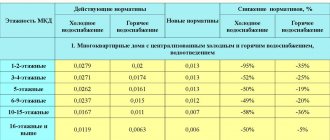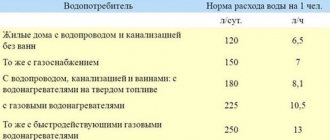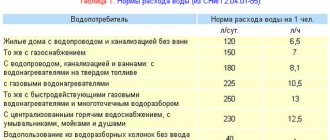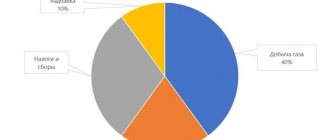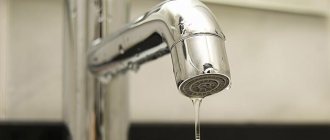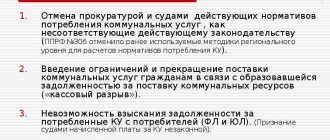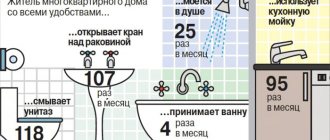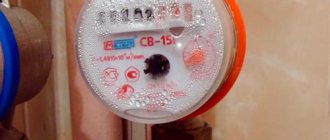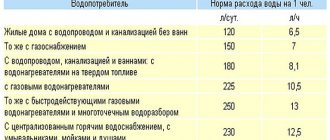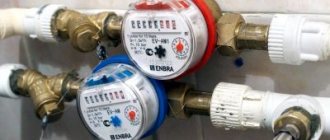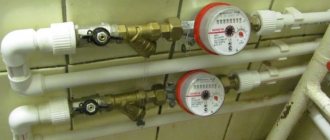The average consumption of thermal energy for hot water supply to the consumer is determined using formulas 20 and 21
(20)
(21)
where: Qgv, Qgvl - average heat consumption for direct hot water supply to the consumer without taking into account heat losses, respectively, in winter and summer, W;
a is the rate of water consumption for hot water supply, l/day per person, approved by local authorities or management. In the absence of approved ports, it is accepted according to the application in accordance with SNiP 2.04.01-85;
m - the number of units of measurement per day (number of residents, students in educational institutions, beds in hospitals)
tхз, tхл - average temperature of cold (tap) water in winter and summer, respectively, °C. Taken during the heating period tхз=5оС, in the summer period tхл=15оС;
c is the specific heat capacity of water, in calculations we take it equal to 4.187 kJ/(kg °C)
0.28 is the conversion factor for the dimensions of physical quantities.
Note: we find the number of residents of residential buildings based on the calculation of n+1 people per n-room apartment, for the remaining buildings we find it according to Appendix B based on the volume of the building given to us and the results obtained experimentally for buildings of a different volume, but of the same type.
m - found by the formula:
m=V/v (22)
where: m is the number of units of measurement per day;
V is the volume of the building according to external dimensions, m3;
c- obtained experimentally, obtained by application
Table 5.1 - average heat consumption for hot water supply in summer for various types of buildings
| Building type | a, l/day person | m, units | Qsrgvz,W | Qsrgvl,W |
| Residential building 9 floors | 120 | 297 | 87047,73 | 69638,18 |
| Residential building 5 floors | 120 | 165 | 48359,85 | 38687,88 |
| Residential building 12 floors | 120 | 132 | 38687,88 | 30950,3 |
| Administrative buildings | 7 | 132 | 2256,79 | 1805,43 |
| Cinemas | 5 | 600 | 7327,25 | 5861,8 |
| Theaters | 5 | 750 | 9159,06 | 7327,25 |
| Kindergartens | 30 | 139 | 10184,87 | 8147,90 |
| Schools | 8 | 100 | 1953,93 | 1813,28 |
| Clinics | 6 | 972 | 14244,17 | 11395,33 |
| Hospitals | 180 | 224 | 98478,24 | 78782,59 |
| Hotels | 200 | 225 | 109908,75 | 87927,00 |
The required amount of heat for hot water supply needs for a certain period is determined by the formula:
(23)
where: nз, nл - the number of hours of operation of the hot water supply system per day, respectively, in winter and summer, hours.
zз, zл - duration of operation of the hot water supply system
respectively in winter and summer, days.
The calculated values of the required amount of heat for the needs of hot water supply for a certain period are shown in Table 5.2.
Table 5.2 - Calculated values of the required amount of heat for hot water supply needs for various types of buildings
| Building type | Qsrgvz,W | nz, h | zz, days | Qsrgvl,W | nl,h | zl, days | Qgv,gJ |
| Residential building 9 floors | 87047,73 | 24 | 250 | 69638,18 | 24 | 85 | 2391,65 |
| Residential building 5 floors | 48359,85 | 24 | 250 | 38687,88 | 24 | 85 | 1328,70 |
| Residential building 12 floors | 38687,88 | 24 | 250 | 30950,3 | 24 | 85 | 1062,96 |
| Administrative buildings | 2256,79 | 12 | 250 | 1805,43 | 12 | 85 | 31,00 |
| Cinemas | 7327,25 | 16 | 250 | 5861,8 | 16 | 85 | 134,21 |
| Theaters | 9159,06 | 5 | 250 | 7327,25 | 5 | 25 | 44,51 |
| Kindergartens | 10184,87 | 16 | 250 | 8147,90 | 16 | 85 | 186,55 |
| Schools | 1953,93 | 12 | 250 | 1813,28 | 12 | 25 | 23,06 |
| Clinics | 14244,17 | 12 | 250 | 11395,33 | 12 | 85 | 195,68 |
| Hospitals | 98478,24 | 24 | 250 | 78782,59 | 24 | 85 | 2705,71 |
| Hotels | 109908,75 | 24 | 250 | 87927,00 | 24 | 85 | 3019,76 |
Note: the number of days of hot water supply in summer for residential buildings, administrative buildings, cinemas, kindergartens, clinics, hospitals and hotels is determined by the formula:
Zl=365-Zht-30
where: Zht is the duration of the heating season in days;
30 - the number of days allocated for repairing the heating main.
For schools and theaters, the number of days of hot water supply in summer is determined by the formula:
Zl=365-Zht-30-60
where: Zht is the duration of the heating season in days;
30 - the number of days allocated for repairing the heating main.
60 - summer holidays (tours).
Determining the load on the DHW source.
Table 5.3 - Calculated values of thermal load on the source of hot water supply
| Building type | Qgv,gJ | Number of buildings, pcs | Qgw total, gJ |
| Residential building 9 floors | 1700 | 17 | 40658,11 |
| Residential building 5 floors | 944,45 | 14 | 18601,75 |
| Residential building 12 floors | 75,56 | 7 | 7440,7 |
| Administrative buildings | 30,36 | 3 | 93,00861 |
| Cinemas | 262,35 | 2 | 268,4235 |
| Theaters | 86,65 | 1 | 44,51303 |
| Kindergartens | 182,18 | 4 | 746,217 |
| Schools | 60,86 | 5 | 115,3039 |
| Clinics | 191,28 | 2 | 391,3614 |
| Hospitals | 2646,99 | 1 | 2705,709 |
| Hotels | 2957,46 | 1 | 3019,765 |
(25)
How to pay without a meter
In order to pay for water without meter readings, you need to calculate it. Calculations can be made using the formula - P = P*N*T*K. The payment amount is the product of the following indicators:
- P – number of consumers registered in the apartment (house);
- N – standard for water;
- T – tariff established in the region;
- K – increasing coefficient.
The final cost of monthly water consumption for consumers without meters will be calculated in this way. It is calculated automatically based on the information about consumers available in the housing and communal services organization.
General principles for performing Gcal calculations
Calculating kW for heating involves performing special calculations, the procedure of which is regulated by special regulations. Responsibility for them lies with utility organizations that are able to help with this work and give an answer regarding how to calculate Gcal for heating and the decoding of Gcal.
Of course, such a problem will be completely eliminated if there is a hot water meter in the living room, since it is in this device that there are already pre-set readings that display the heat received. By multiplying these results by the established tariff, it is possible to obtain the final parameter of the heat consumed.
Average water consumption per person per month according to the meter
It should be noted that for most consumers, the presence of meters is still beneficial. If the average flow rate is 6.935 cubic meters. cold. and 4.75 cu. hot water for one person, then for a family of four per month it will be approximately 18 and 15 cubic meters.
In fact, if there are meters, such a family can spend one and a half to two times less cubic meters. These water consumption rates may vary among families and regions. However, with the economical use of water resources, the consumption in the presence of metering devices will be significantly less.
Similar
| Ministry of Education and Science, Youth and Sports of Ukraine National Metallurgical Academy of Ukraine Yu. A. Gichev. Heat supply sources for industrial enterprises. Part I: Lecture notes: Dnepropetrovsk: NmetAU, 2011. – 52 p. | Ministry of Education and Science of Ukraine Ministry of Industrial Policy of Ukraine National Metallurgical Academy of Ukraine - State Institute for Training and Retraining of Industrial Personnel (Gipoprom) Edited by Professor Shestopalov G.move to 0-16320291 |
| Ministry of Education and Science of Ukraine Ministry of Industrial Policy of Ukraine educational and scientific complex "National Metallurgical Academy of Ukraine State Institute for Training and Retraining of Industrial Personnel (Gipoprom)" Edited by Professor Shestopalov G.move to 0-3612123 | Ministry of Education and Science, Youth and Sports of Ukraine National University of Physical Education and Sports of UkraineThe work was carried out at the National University of Physical Education and Sports of Ukraine, Ministry of Education and Science, Youth... |
| Ministry of Education and Science, Youth and Sports of UkraineMinistry of Education and Science, Youth and Sports of Ukraine, Sevastopol National Technical University (Sevntu) from 23 to… | Ministry of Education and Science, YOUTH AND SPORTS OF UKRAINE Ministry of Education and Science, Youth and Sports of the Autonomous Republic of Crimea RVU "Crimean Humanitarian University" (Yalta) Institute of Economics and Management control work in the discipline |
| Ministry of Education and Science of Ukraine Ministry of Industrial Policy of Ukraine National Metallurgical Academy of Ukraine - State Institute for Training and Retraining of Industrial Personnel (Hypoprom) Edited by Professor Shestopalov G. Sociology. Course of lectures // Shestopalov G. G., Amelchenko A. E., Kurevina T. V., Laguta L. N., edited by Prof. G. G. Shestopalov. – Dnepropetrovsk:... | National University of Physical Education and Sports of Ukraine Gridko Lyudmila AnatolievnaThe work was carried out at the National University of Physical Education and Sports of Ukraine, Ministry of Education and Science, Youth... |
| National University of Physical Education and Sports of UkraineThe work was carried out at the National University of Physical Education and Sports of Ukraine, Ministry of Education and Science, Youth... | National University of Physical Education and Sports of UkraineThe work was carried out at the National University of Physical Education and Sports of Ukraine, Ministry of Education and Science, Youth... |
Documents
Documents
Other methods for calculating heat volume
You can calculate the amount of heat entering the heating system in other ways.
The formula for calculating heating in this case may differ slightly from the above and have two options:
- Q = ((V1 * (T1 - T2)) + (V1 - V2) * (T2 - T)) / 1000.
- Q = ((V2 * (T1 - T2)) + (V1 - V2) * (T1 - T)) / 1000.
All variable values in these formulas are the same as before.
Based on this, we can say with confidence that the calculation of kilowatts of heating can be done on your own. However, do not forget about consultation with special organizations responsible for supplying heat to homes, since their principles and calculation system may be completely different and consist of a completely different set of measures.
Having decided to construct a so-called “warm floor” system in a private house, you need to be prepared for the fact that the procedure for calculating the volume of heat will be much more complicated, since in this case it is necessary to take into account not only the features of the heating circuit, but also provide for the parameters of the electrical network from which and the floor will be heated. At the same time, the organizations responsible for monitoring such installation work will be completely different.
Many owners often face the problem of converting the required amount of kilocalories into kilowatts, which is due to the use of measuring units in the international system called “C” by many auxiliary aids. Here you need to remember that the coefficient converting kilocalories into kilowatts will be 850, that is, in simpler terms, 1 kW is 850 kcal. This calculation procedure is much simpler, since calculating the required volume of gigacalories is not difficult - the prefix “giga” means “million”, therefore, 1 gigacalorie is 1 million calories.
In order to avoid errors in calculations, it is important to remember that absolutely all modern heat meters have some error, but often within acceptable limits. The calculation of such an error can also be done independently, using the following formula: R = (V1 - V2) / (V1+V2) * 100, where R is the error of the common house heating meter
V1 and V2 are the parameters of water flow in the system already mentioned above, and 100 is the coefficient responsible for converting the resulting value into a percentage. In accordance with operational standards, the maximum permissible error may be 2%, but usually this figure in modern instruments does not exceed 1%.
Current laws in 2021
The setting of consumption standards and charging for utility services is based on the Rules for Consumption of Utilities of 2011. Additionally, these consumption standards are regulated by Decree of the Government of the Russian Federation No. 354, the latest edition of which appeared in 2020.
Decree of the Government of the Russian Federation No. 354
Appendix No. 2 of this document covers the following issues:
- Features of calculating the cost of resources in the presence of individual appliances in the apartment, as well as in their absence;
- Differences in standards for different types of premises. The amount for water consumption in private houses is calculated according to a different scheme than in an apartment in an apartment building. Premises not intended for living also have their differences;
- Accrual parameters.
From the first part of the Resolution you can understand exactly what principles are used to form the final payment amount. The document covers the mutual rights and obligations of citizens and public utilities, as well as the procedure for using common building utilities.
Decree of the Government of the Russian Federation No. 306
More accurate information on the size of the standards can be found in the Rules for establishing standards for the consumption of utility services. This document was approved in 2006, and gives local authorities the right to independently determine the size of the standards. In 2020, amendments were made to the document obliging each entity to independently establish the amount of utility consumption standards.
The right to regulate standards by municipal authorities is enshrined in Federal Law No. 210. At the same time, self-government bodies cannot establish standards in an arbitrary manner; they must necessarily rely on the framework prescribed by federal legislation.
Decree of the Government of the Russian Federation No. 1498
Decree of the Government of the Russian Federation No. 1498 covers all issues related to the establishment of standards for the consumption of cold and hot water, as well as the process of calculating payments for residents of an apartment building in the event that individual metering devices are not installed in the apartment. From here you can find out how the final indicators are formed, and how they can be affected by the number of residents registered at a given address or the number of people actually living there.
The latest edition of the document was published in 2021; according to the updates, the accruals will also be affected by the characteristics of the residential premises, including the number of floors of the building, the condition and wear and tear of utilities, etc.
How to calculate the cost of hot water
According to Decree No. 1149 of the Government of the Russian Federation (dated November 8, 2012), the cost of hot water is calculated according to a two-component tariff for closed and open heat supply systems:
- in open ones - using components for coolant and thermal energy (according to Article 9, Clause 5 of Federal Law No. 190);
- in closed ones - using components for cold water and thermal energy (according to Article 32, paragraph 9 of Federal Law No. 416).
The format of the invoices has also changed, dividing the service into two lines: consumption of hot water (in tons) and thermal energy - Q. Previously, the tariff for hot water supply (hot water supply) was calculated for 1 m3, already including the cost of this volume of cold water and thermal energy consumed to heat it.
Dependency of calculation order
Depending on the price of the components, the estimated cost of 1 m3 of hot water supply is determined. For calculations, consumption standards in force in the territory of the municipality are used.
The procedure for calculating the cost of hot water by meter depends on:
- type of home heating system,
- the presence (absence) of a common house appliance, its technical characteristics that determine whether it can distribute Q for water supply and heating needs,
- presence (absence) of individual devices,
- suppliers of thermal energy and coolant.
The division into the price per cubic meter of cold water and heating costs, among other things, should encourage management companies servicing the housing stock to combat direct heat loss - to insulate the risers. For owners, two-component tariffing means that the payment for 1 m3 of hot water supply may vary relative to the standard if the actual consumption Q exceeds.
Apartment buildings without building flow meters
The quantity Q for heating 1 m3 of hot water is determined according to the recommendations of the State Tariff Committee, according to which the volume of thermal energy is calculated using the formula: Q = c * p * (t1– t2) * (1 + K).
This formula for consumed cubic meters takes into account the heat loss coefficient on centralized hot water pipelines.
- C – heat capacity of water (specific value): 1×10-6 Gcal/kg. x 1ºC;
- P – weight of water (volume); 983.18 kgf/m3 at t 60° C;
- t1 is the average annual temperature of hot water from centralized systems, taken as 60°C (the indicator does not depend on the heat supply system);
- t2 is the average annual cold water temperature from centralized systems, taken according to the actual data of those enterprises that supply cold water to organizations that prepare hot water (for example, 6.5°C).
Based on this, in the example below, the amount of thermal energy will be:
Q=1*10-6 Gcal/kg * 1ºC * 983.18 kgf/m3 * 53.5°C * (0.35 + 1) = 0.07 Gcal/m³
Its cost for 1 m3:
1150 rub./Gcal (DHW tariff) * 0.07 Gcal/m³ = 81.66 rub./m³
DHW tariff:
16.89 RUR/m³ (cold water component) + 81.66 RUR/m³ = 98.55 RUR/m³
Example No. 2 of calculation without taking into account the heat loss coefficient on centralized pipelines for one person (without an individual water meter):
0.199 (Gcal - standard hot water consumption per person) * 1540 (rubles - cost of 1 Gcal) + 3.6 (m3 - standard hot water consumption per person) * 24 (rubles - cost of m3) = 392.86 rubles.
Apartment buildings with house flow meters
The actual payment for hot water in houses equipped with communal meters will change monthly, depending on the volumetric indicators of thermal energy (1 m3), which, in turn, depend on:
- quality of the metering device,
- heat loss in hot water supply networks,
- excess coolant supply,
- degree of adjustment of the optimal flow rate Q, etc.
If there are individual and common household appliances, payment for hot water supply is calculated according to the following algorithm:
- The readings of the house flow meter are taken according to two indicators: A - the amount of thermal energy and B - the amount of water.
- The amount of thermal energy spent per 1 m3 of coolant is calculated by dividing A by B = C.
- The apartment water meter readings in m3 are taken and multiplied by the result C to obtain the Q size for the apartment (D value).
- The D value is multiplied by the tariff.
- A component is added to heat the coolant.
Example for consumption of 3 m3 according to an apartment meter:
Moreover, if it is difficult to influence the results of general house readings using one apartment, then the readings of individual water meters can be influenced by legal methods, for example, by installing water savers: https://water-save.com/.
Read more
Increasing coefficients
For those who do not have individual hot and cold water meters, utility bills are charged according to an increasing coefficient. This is the indicator by which the resource consumption standard is multiplied. The concept of a multiplying factor was introduced in 2014; in 2021 it is 1.5.
The coefficient is applied if a person does not provide data on water consumption for 3 months for the following reasons:
- Metering devices are not installed;
- The meters have expired and new ones have not been installed within 3 months;
- The devices became unusable, but were not replaced in time;
- The tenant does not provide meter data and does not give utility workers access to metering devices.
The increasing factor is applied only when calculating the consumption of heat treatment plants; it is not used when calculating payments for wastewater disposal.
Heat meter calculation
Calculation of a heat meter involves choosing the standard size of the flow meter. Many people mistakenly believe that the diameter of the flow meter must correspond to the diameter of the pipe on which it is installed.
The diameter of the heat meter flow meter must be selected based on its flow characteristics.
- Qmin — minimum flow rate, m³/h
- Qt — transition flow, m³/h
- Qn — nominal flow rate, m³/h
- Qmax — maximum permissible flow rate, m³/h
0 – Qmin – the error is not standardized – long-term operation is allowed.
Qmin - Qt - error no more than 5% - long-term operation is allowed.
Qt – Qn (Qmin – Qn for flow meters of the second class for which the Qt value is not specified) – error no more than 3% – long-term operation is allowed.
Qn - Qmax - error no more than 3% - work is allowed for no more than 1 hour per day.
It is recommended to select flow meters for heat meters in such a way that the calculated flow rate falls in the range from Qt to Qn, and for flow meters of the second class for which the Qt value is not indicated, in the flow range from Qmin to Qn.
In this case, one should take into account the possibility of reducing the coolant flow through the heat meter, associated with the operation of the control valves, and the possibility of increasing the flow through the heat meter, associated with the instability of the temperature and hydraulic conditions of the heating network. Regulatory documents recommend selecting a heat meter with the closest higher value of the nominal flow rate Qn to the calculated coolant flow. Such an approach to choosing a heat meter practically eliminates the possibility of increasing the coolant flow rate above the calculated value, which quite often has to be done in real heat supply conditions.
The above algorithm displays a list of heat meters that, with the stated accuracy, will be able to take into account a flow rate one and a half times higher than the calculated flow rate and three times less than the calculated flow rate. A heat meter chosen in this way will, if necessary, increase the consumption at the facility by one and a half times and reduce it by three times.
